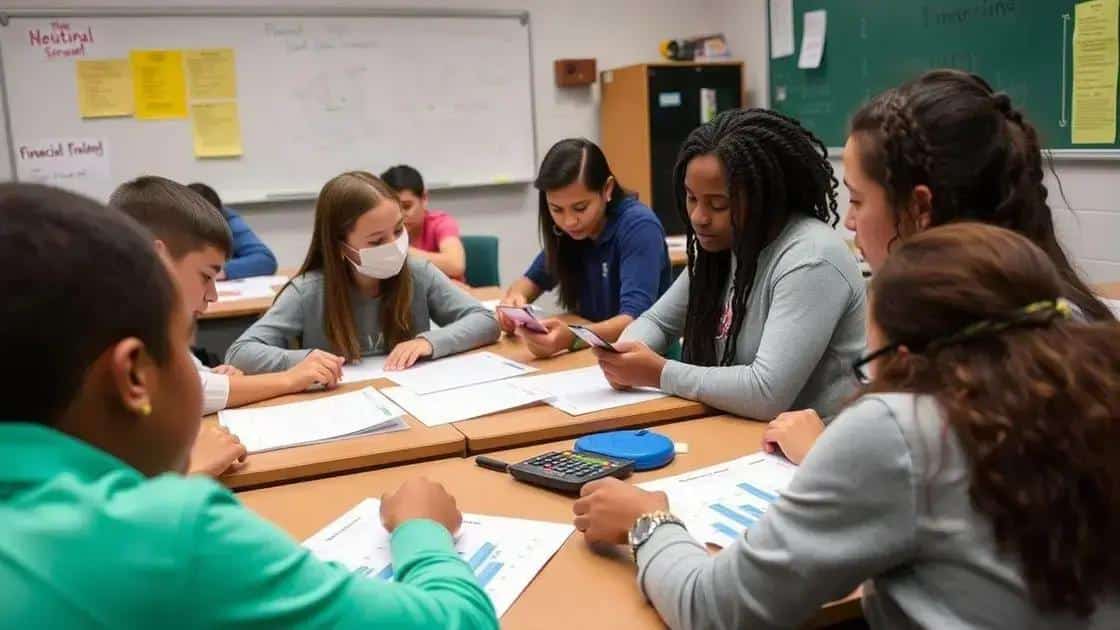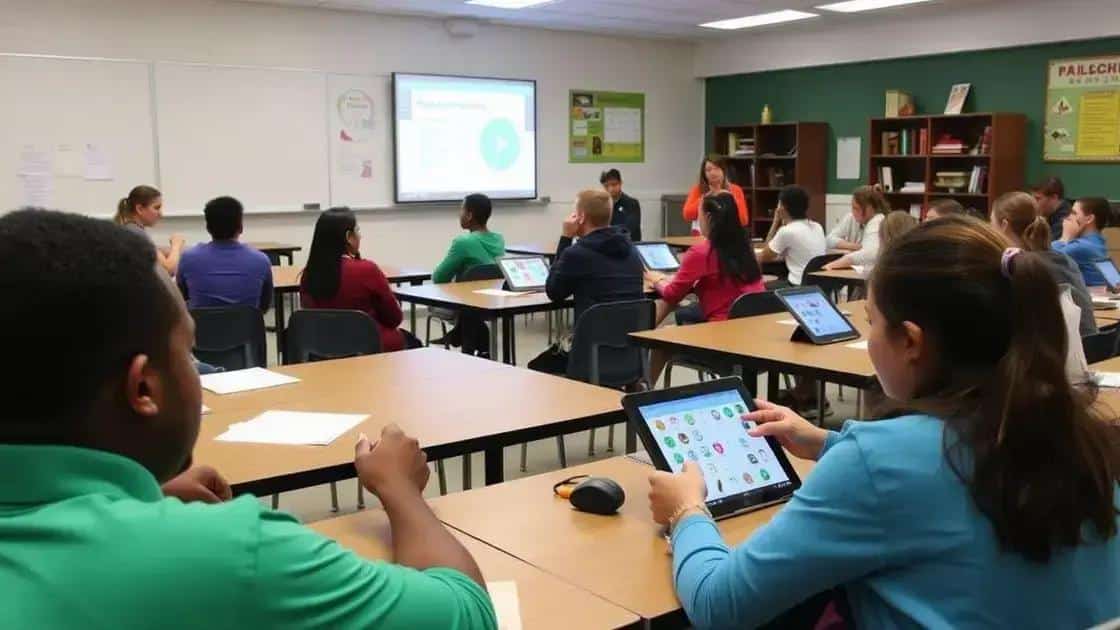Full financial literacy in schools: an urgent need

Full financial literacy in schools equips students with essential money management skills, enabling them to budget, save, invest, and make informed financial decisions for their future.
Full financial literacy in schools is becoming increasingly essential in today’s economy. Many students graduate without the skills to manage personal finances. Have you ever thought about how this impacts their futures?
Understanding the importance of financial literacy
Financial literacy is crucial for success in today’s world. It involves understanding how money works, including how to earn, save, invest, and spend wisely. When students develop financial literacy skills, they are better equipped to make informed decisions that can greatly impact their futures.
Why Financial Literacy Matters
Understanding the importance of financial literacy goes beyond basic math. It teaches students essential life skills.
- It helps individuals avoid debt by managing expenses.
- It encourages saving for emergencies and future goals.
- It empowers people to make informed choices about credit and loans.
Another key point to consider is that financial literacy contributes to overall economic health. When individuals can manage their finances effectively, they are likely to contribute to a more stable economy. Additionally, financially literate citizens can participate more actively in community affairs, advocating for better financial policies and practices.
Life Skills Developed through Financial Literacy
As students learn about money management, they also acquire valuable life skills such as planning and critical thinking. These skills are not just applicable to finance but also to various aspects of their lives, such as education and career choices. By understanding the value of budgeting and planning, students create a solid foundation for their future.
Moreover, introducing financial literacy in schools can foster a sense of responsibility. Students begin to understand that their financial choices have consequences, encouraging them to think carefully about their decisions. This focus on accountability can lead to healthier financial habits as they grow.
Ultimately, teaching financial literacy in schools is about preparing students for real-world challenges. These skills will help them navigate their financial futures successfully and live fulfilling lives.
Key concepts every student should know
Understanding key concepts is essential for developing strong financial literacy. Students should start by learning about a few fundamental ideas that will help them manage their finances effectively.
Essential Financial Concepts
One crucial aspect is the difference between needs and wants. Recognizing what is necessary for living versus what is desirable helps students make better spending choices. For example, while food and shelter are needs, expensive gadgets can often fall into the wants category.
- Understanding budgets: A budget is a plan that outlines income and expenses.
- The importance of saving: Saving money can help students prepare for unexpected costs.
- Interest rates: Learning about how interest works can affect borrowing and saving decisions.
Another important concept is the time value of money. This principle explains how money can grow over time when invested. For instance, if a student saves money now, they can earn interest, making their savings larger in the future.
Practical Applications of Key Concepts
Understanding credit scores is also vital. A good credit score can lead to lower interest rates on loans and better chances of approval. By learning how credit works, students can make informed decisions that benefit them later.
Moreover, concepts like investing can seem complicated, but they are essential. Students should know basic investment types like stocks, bonds, and mutual funds. Understanding these concepts can help them grow their wealth over time.
Many schools and programs now offer practical experiences that allow students to apply these concepts in real-life situations. By simulating financial scenarios, students can understand how their decisions impact their finances, making it easier to grasp the benefits of financial literacy.
Effective teaching methods for financial literacy

Teaching financial literacy effectively requires engaging methods that resonate with students. It’s important to create an environment where students feel comfortable exploring financial concepts.
Interactive Learning Techniques
One effective method is using interactive games and simulations. These activities allow students to experience real-life financial decisions in a safe setting. For example, a budgeting game can show students how to allocate resources wisely. By making learning fun, students are more likely to retain the concepts.
- Using role-playing scenarios to teach decision-making skills.
- Implementing group projects that focus on real-world financial problems.
- Hosting guest speakers from the finance industry to share their expertise.
Another powerful approach involves integrating technology into lessons. Digital tools and apps can make learning more dynamic. Students can use online budgeting tools and savings apps, which help them apply concepts to their personal finances. Through these tools, they can monitor progress and set financial goals.
Incorporating Real-Life Examples
Bringing real-life examples into the classroom can also enhance understanding. Discussing current events related to finance makes the learning relevant and timely. It’s helpful to show how financial literacy impacts daily life, such as understanding loans, credit scores, and investments.
Teachers might also implement project-based learning where students create their own business plans. This exercise requires them to think critically about costs, revenues, and budgeting. It fosters creativity and allows them to practice essential financial skills in a practical context.
Furthermore, collaboration with parents can reinforce learning at home. Providing resources and workshops for parents can help them support their children’s financial education. It’s important to establish a community effort that emphasizes the value of financial literacy.
Real-life applications of financial skills
Real-life applications of financial skills are crucial for students to understand how their education translates into everyday situations. By applying what they learn about financial literacy, students can manage their money more effectively.
Budgeting for Daily Life
One primary application is budgeting. Creating a budget helps students plan their spending and savings. They learn to track income and expenses, which is essential for preparing for future needs. Using budgeting apps can make this process engaging and efficient.
- Identify fixed and variable expenses.
- Set savings goals for short-term and long-term.
- Adjust the budget as needed to stay on track.
Learning to budget allows students to make informed decisions about their money. They become aware of the importance of living within their means, which can prevent debt in the future.
Understanding Credit and Loans
Another important skill is understanding credit and loans. Students should know how credit scores work and why they matter. A good credit score can lead to better loan terms, which can save money in the long run. Lessons should include how to responsibly use credit cards without incurring debt.
For example, when students learn to pay off their credit card balances each month, they avoid interest charges. This practice builds a good credit history over time, which is an asset when applying for loans or mortgages.
Additionally, applying for a student loan requires students to weigh their options carefully. They must understand interest rates, monthly payments, and the total cost of borrowing. By applying their financial skills, they can make responsible decisions that affect their educational and career paths.
Lastly, investing is a real-life application that can significantly impact financial future. Students should be introduced to the basics of investing, such as stocks, bonds, and mutual funds. Understanding the concept of compounding can motivate them to start saving and investing early, leading to greater financial stability.
The role of parents and community in financial education
The role of parents and the community is vital in promoting financial education. Parents are often the first teachers of money management. They influence their children’s attitudes toward saving, spending, and investment.
Engagement at Home
When parents discuss finances openly, they create a positive environment for learning. Family conversations about money can include budgeting, saving for family trips, or discussing the importance of a good credit score. This transparency helps children develop a healthy relationship with money.
- Setting up a family budget together can teach responsibility.
- Encouraging children to save their allowance for something special.
- Discussing financial goals as a family fosters teamwork.
Additionally, allowing children to make small financial decisions enhances their confidence. Parents can guide them through these choices, helping them weigh the pros and cons.
Community Contributions
Beyond the home, the community plays a significant role in financial education. Local schools and organizations can offer programs that teach essential financial skills. Workshops and seminars provide information on topics like budgeting, investing, and managing debt.
Moreover, community members can serve as mentors. Sharing real-life experiences with finances can add context and relatability. Schools can invite professionals from the financial sector to discuss career paths and real-world financial literacy applications.
Programs that encourage collaboration between schools and local businesses offer valuable perspectives. Students can learn the importance of financial literacy in various professional fields. Ultimately, a strong support network helps students apply what they learn about managing money effectively.
financial literacy is essential for preparing students for their future. By understanding key concepts, students can manage their finances effectively. Parents and the community play a significant role in supporting this education. Together, we can ensure that future generations are equipped with the skills they need to succeed financially.
FAQ – Frequently Asked Questions about Financial Literacy in Schools
Why is financial literacy important for students?
Financial literacy is important as it equips students with the necessary skills to manage their money, budget effectively, and make informed financial decisions.
How can parents support their children’s financial education?
Parents can support financial education by discussing money matters openly, creating budgets together, and encouraging saving and responsible spending habits.
What role do schools play in teaching financial literacy?
Schools play a crucial role by providing structured financial education programs that cover budgeting, saving, investing, and understanding credit.
How can the community help improve financial literacy among youth?
The community can help by offering workshops, seminars, and mentorship programs that teach practical financial skills and connect students with real-life financial experiences.





